63: The descendants of the French regional patterns: 1
A great many regional patterns were exported from France and subsequently copied elsewhere. Some of them became local standards in their own right.
Having looked closely at the court figures of the various French regional patterns, it's worthwhile considering which patterns went further afield and ended up in different parts of Europe. We know well enough that Rouen 2 came to England and became our standard pattern, which in its turn has spread throughout the world, in particular on the back of poker, whist and bridge. I will not deal with this standard here, as it is the topic of much of this blog. I've illustrated some of the other descendants on pages 11, 16 and 25, but I want to look at further examples more closely. I will give more examples in these two pages than I dealt with in my The Playing Card article.
Lyons 1 Pattern
Lyons 1 was exported to Italy and was in use in the nineteenth century, but doesn't seem to be extant today.
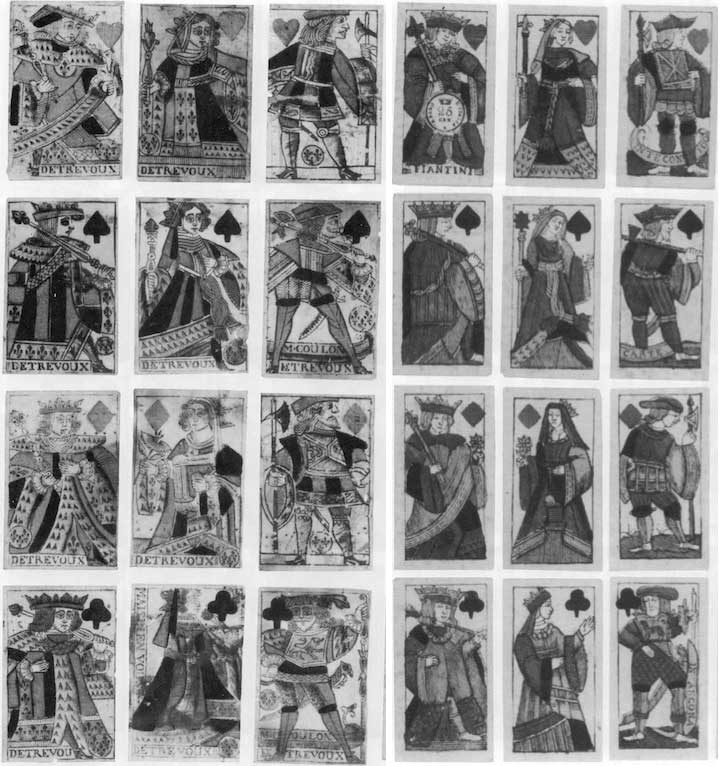
Lyons 2 Pattern
The Lyons 2 pattern ended up in Austria as the ornate Viennese patterns (A & B) with clear changes to some of the orientations and attire. There are also descendants in Switzerland.
 Above: Lyons 2 pattern by IV
Above: Lyons 2 pattern by IV
The double-ended version was produced in large quantities in Turnhout towards the end of the nineteenth century.
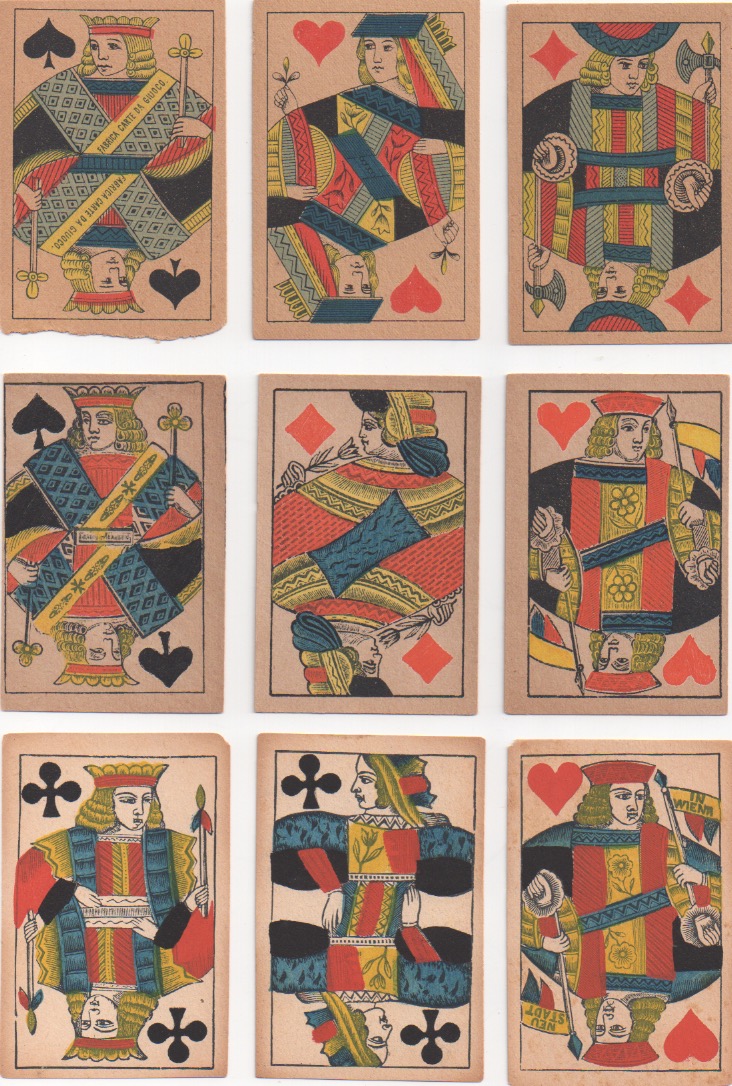 Above: three versions of the Viennese pattern from Turnhout; the top one is clearly for the Italian market, the middle one is by van Genechten, and the bottom one has "In Wien" on the JH's pennant.
Above: three versions of the Viennese pattern from Turnhout; the top one is clearly for the Italian market, the middle one is by van Genechten, and the bottom one has "In Wien" on the JH's pennant.
 Above: Austrian A ("Large crown") all suit signs on the left
Above: Austrian A ("Large crown") all suit signs on the left
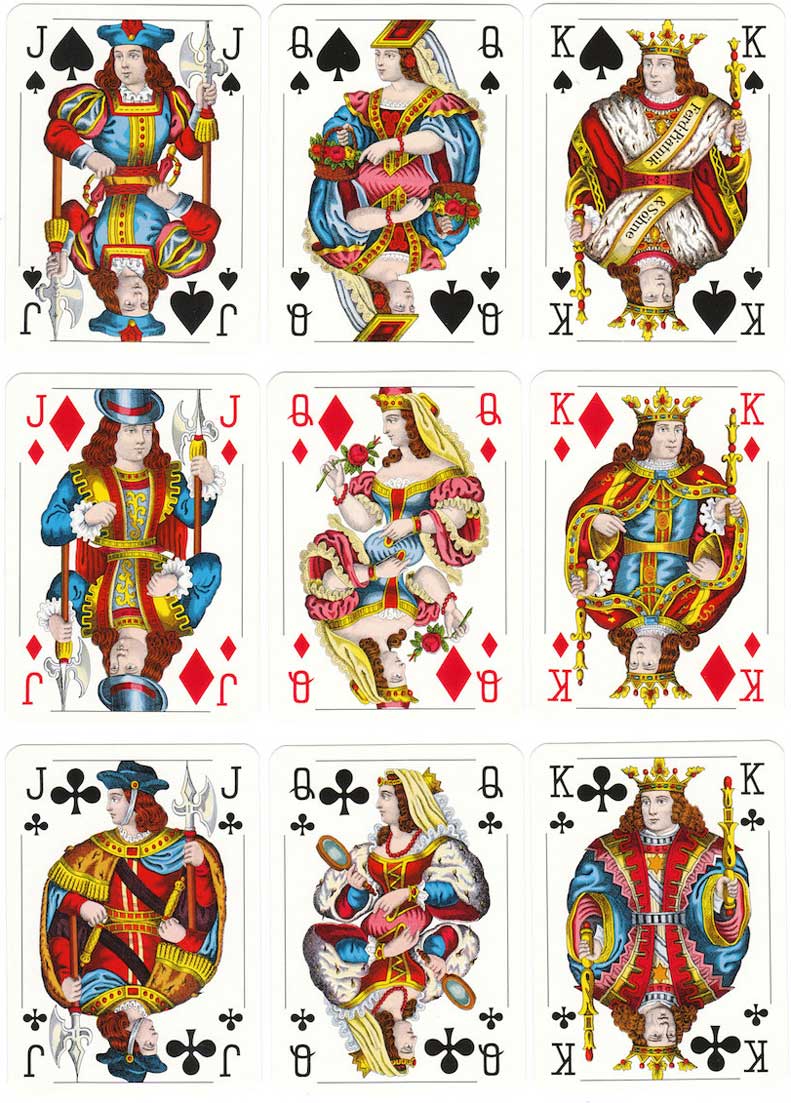 Above: Austrian B with some alteration to the direction of the heads and attributes: all suit signs to the left.
Above: Austrian B with some alteration to the direction of the heads and attributes: all suit signs to the left.
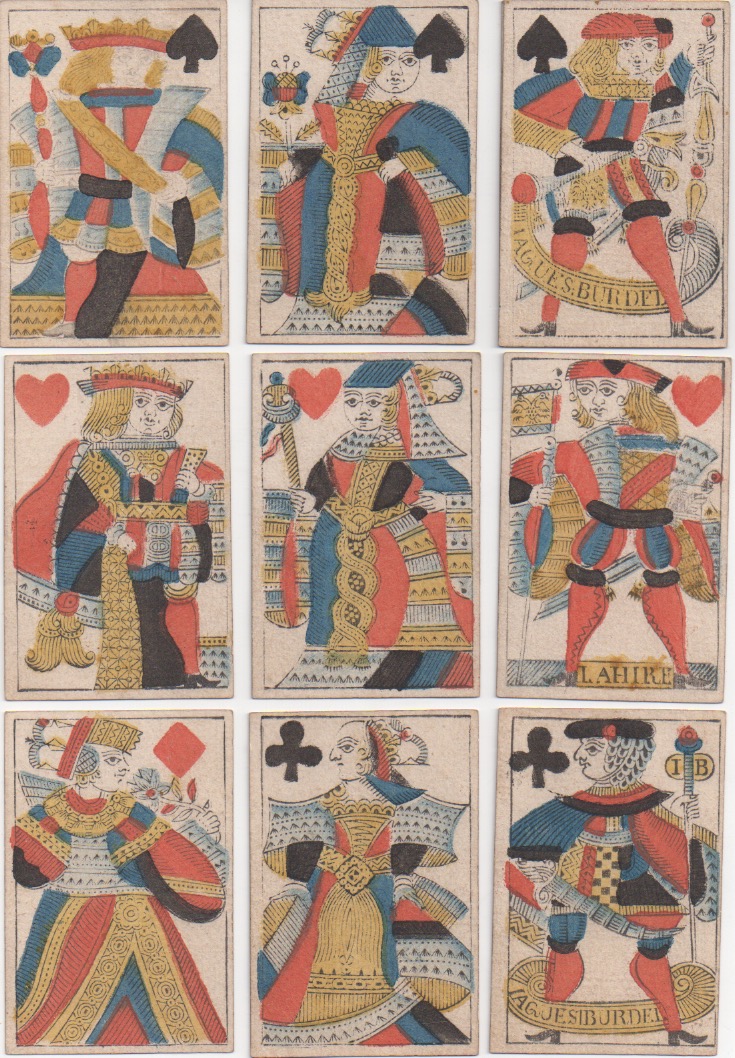 Above: a Swiss version by Jaques Burdel, keeping the original postures, c.1800
Above: a Swiss version by Jaques Burdel, keeping the original postures, c.1800
 Above: Swiss version of the Lyons 2 pattern by Claude Burdel with all suit signs on the left and several courts turned. A very much simplified treatment with a completely altered JC.
Above: Swiss version of the Lyons 2 pattern by Claude Burdel with all suit signs on the left and several courts turned. A very much simplified treatment with a completely altered JC.
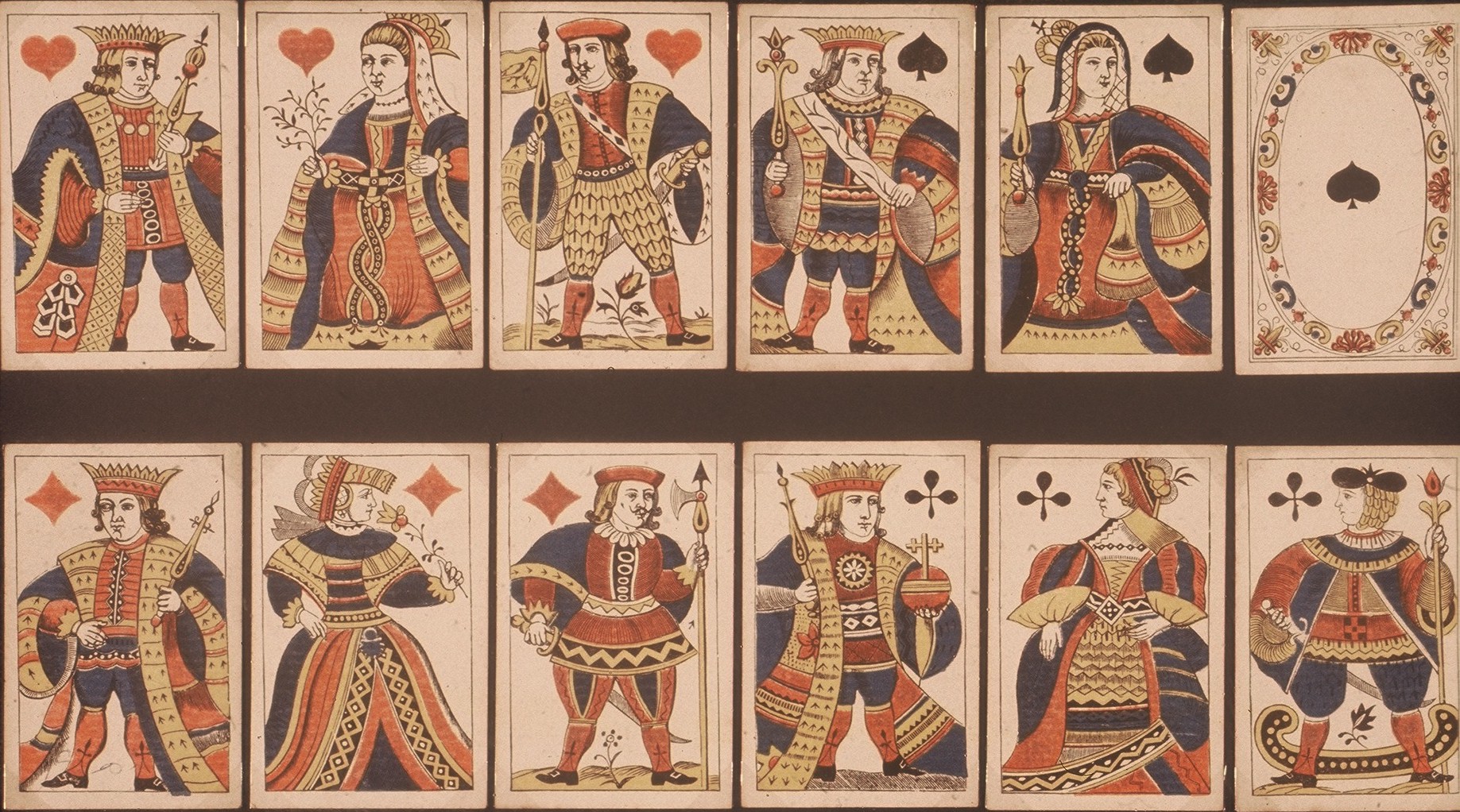 Above: a more sophisticated Swiss version with the original orientations, except that the KC has been completely altered; he is now like the Dauphiné KC with a sceptre rather than a sword.
Above: a more sophisticated Swiss version with the original orientations, except that the KC has been completely altered; he is now like the Dauphiné KC with a sceptre rather than a sword.
Rouen 1 Pattern
The first Rouen pattern remained single-figure into the 20th century in the guise of the Liège pattern.
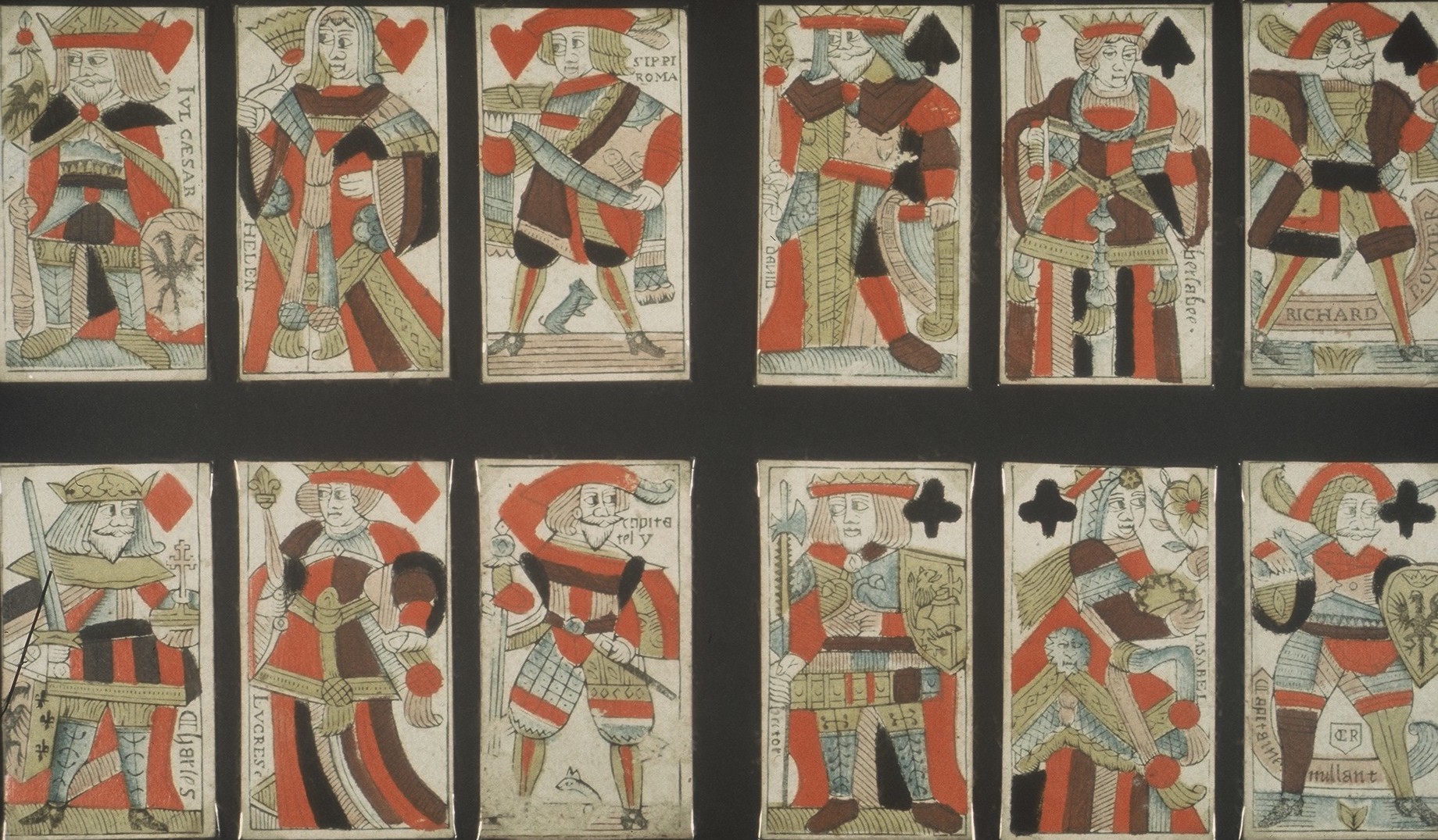 Above: Rouen 1 pattern by Bouvier, c.1750.
Above: Rouen 1 pattern by Bouvier, c.1750.
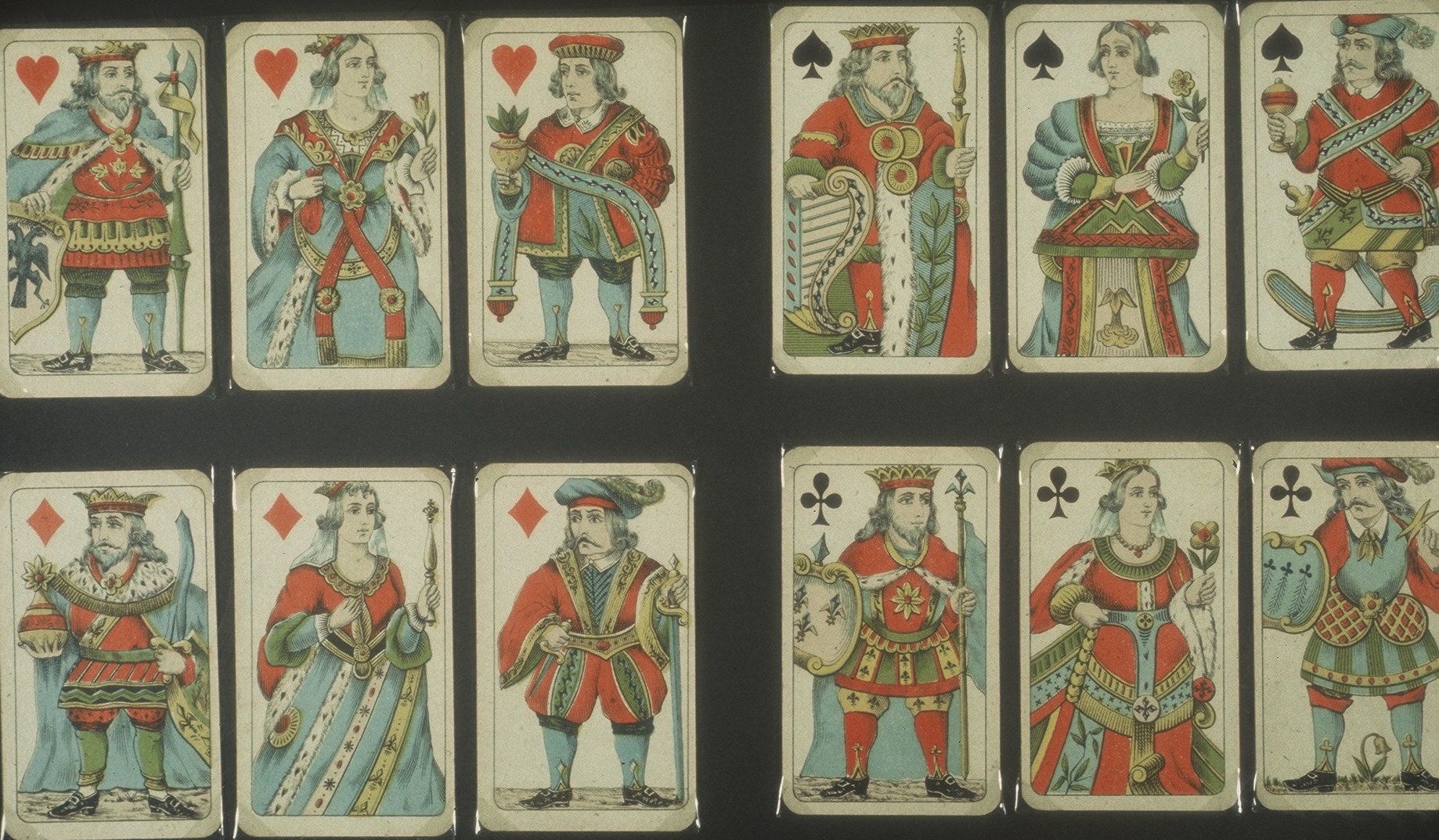 Above: Liège pattern by Brepols, c.1900, all suit signs on the left.
Above: Liège pattern by Brepols, c.1900, all suit signs on the left.
Paris 1 Pattern
There are numerous descendants of Paris 1. Here is an early version by Jean Gisaine of Dinant from c.1750. The pattern is unchanged from the French original.
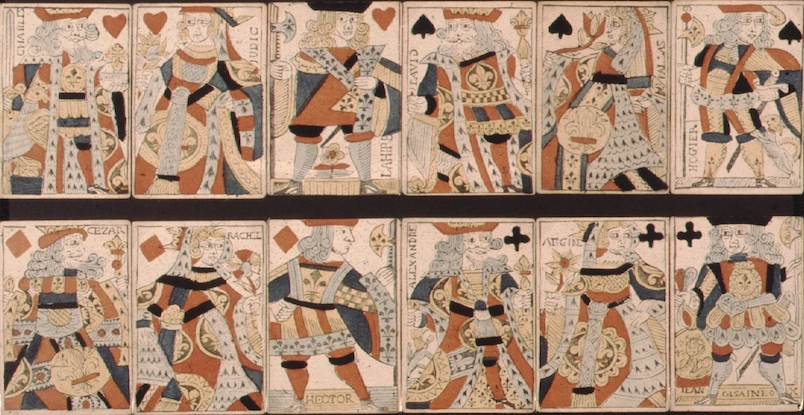
By 1880 Belgian versions were double-ended with all pips on the left. Some alteration of the postures has occurred and in the case of the JS and JH their attributes have changed hands.

 Above: an anonymous Belgian pack of c.1880.
Above: an anonymous Belgian pack of c.1880.
Müller also produced a single-figure version in the second half of the 19th century.
 Above: Paris 1 by Müller: the JH is from Paris 2; although most pips are on the left, the JS has his on the right.
Above: Paris 1 by Müller: the JH is from Paris 2; although most pips are on the left, the JS has his on the right.
One group could be suitably referred to as the North European version. It spread with various alterations to Belgium, Holland, North Germany and Scandinavia. The Scandinavian group developed its own characteristics and altered the orientation of the figures for no apparent reason.
 Above: Boman, Stockholm, c.1850
Above: Boman, Stockholm, c.1850
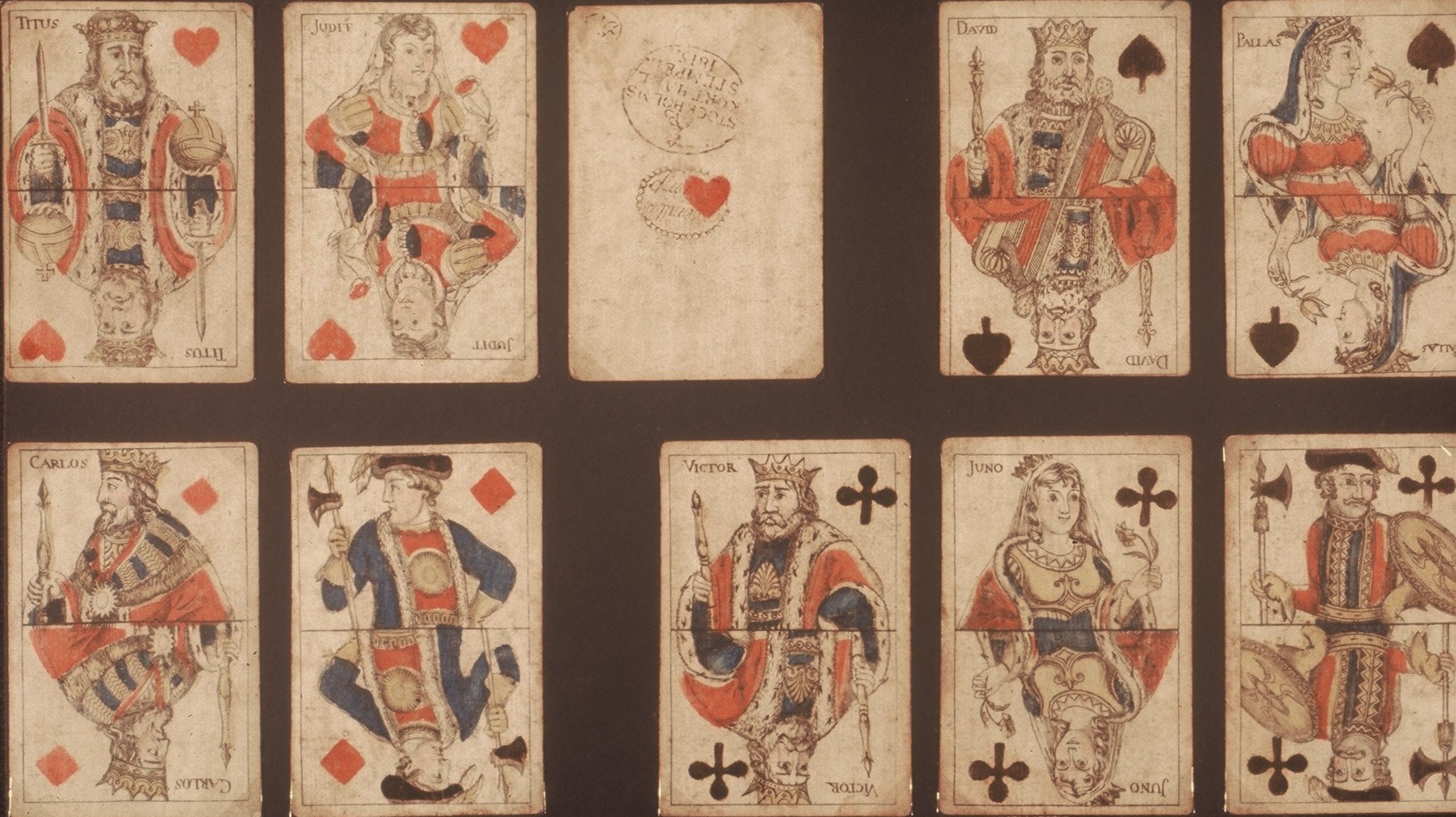 Above: Stockholm, 1815. In this version all the courts have been turned with pips on the right and there are altered names on the kings and queens.
Above: Stockholm, 1815. In this version all the courts have been turned with pips on the right and there are altered names on the kings and queens.

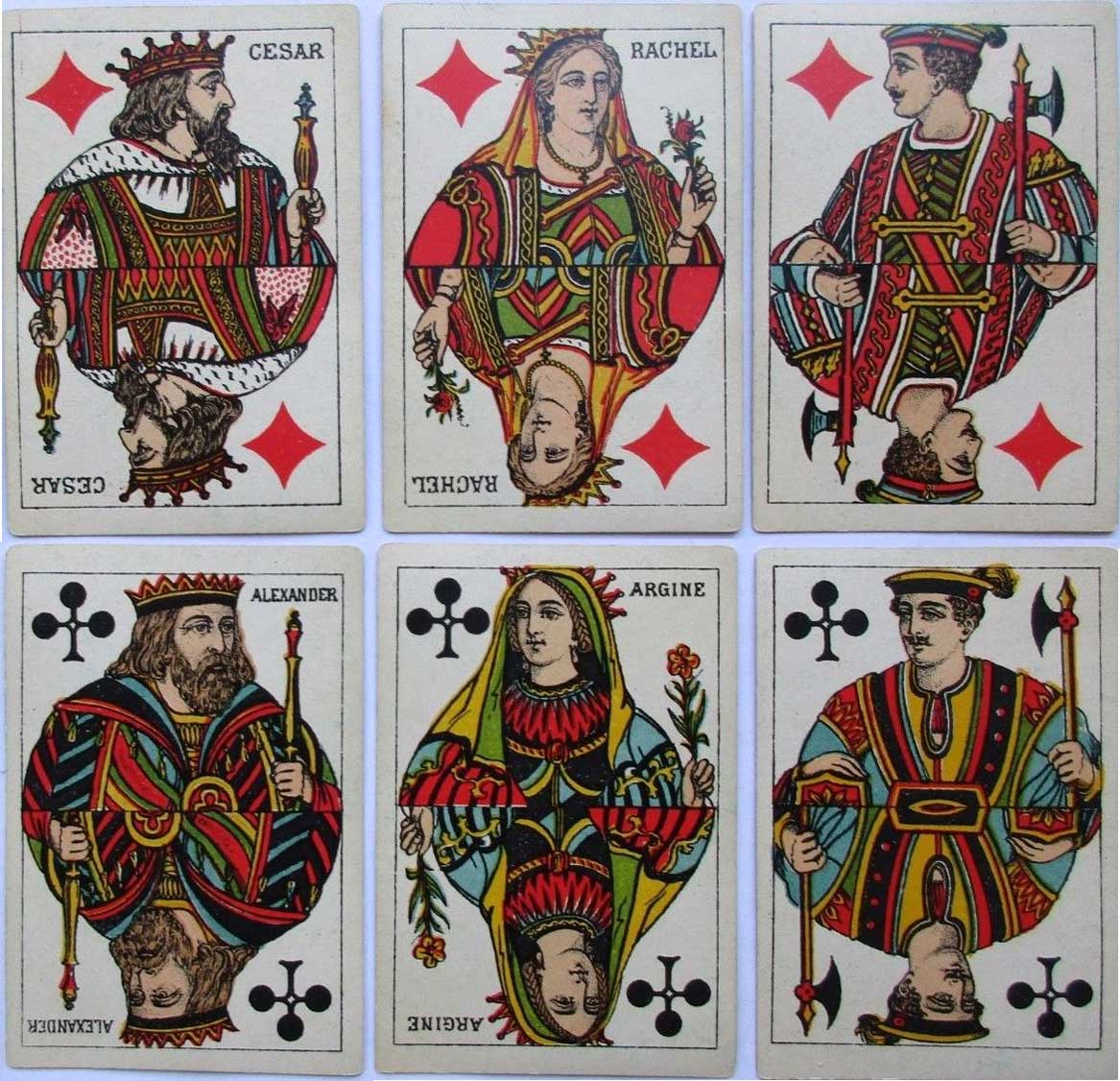 Above: a finely engraved version by Litografiska Norrkoping, c.1890
Above: a finely engraved version by Litografiska Norrkoping, c.1890
A subgroup of this version was influenced by Runge, who introduced his own reworking of the Paris pattern in 1809 and 1810. The earlier version was much less like its model, but the second version had features which can be found in a number of North German pack in the 19th century.
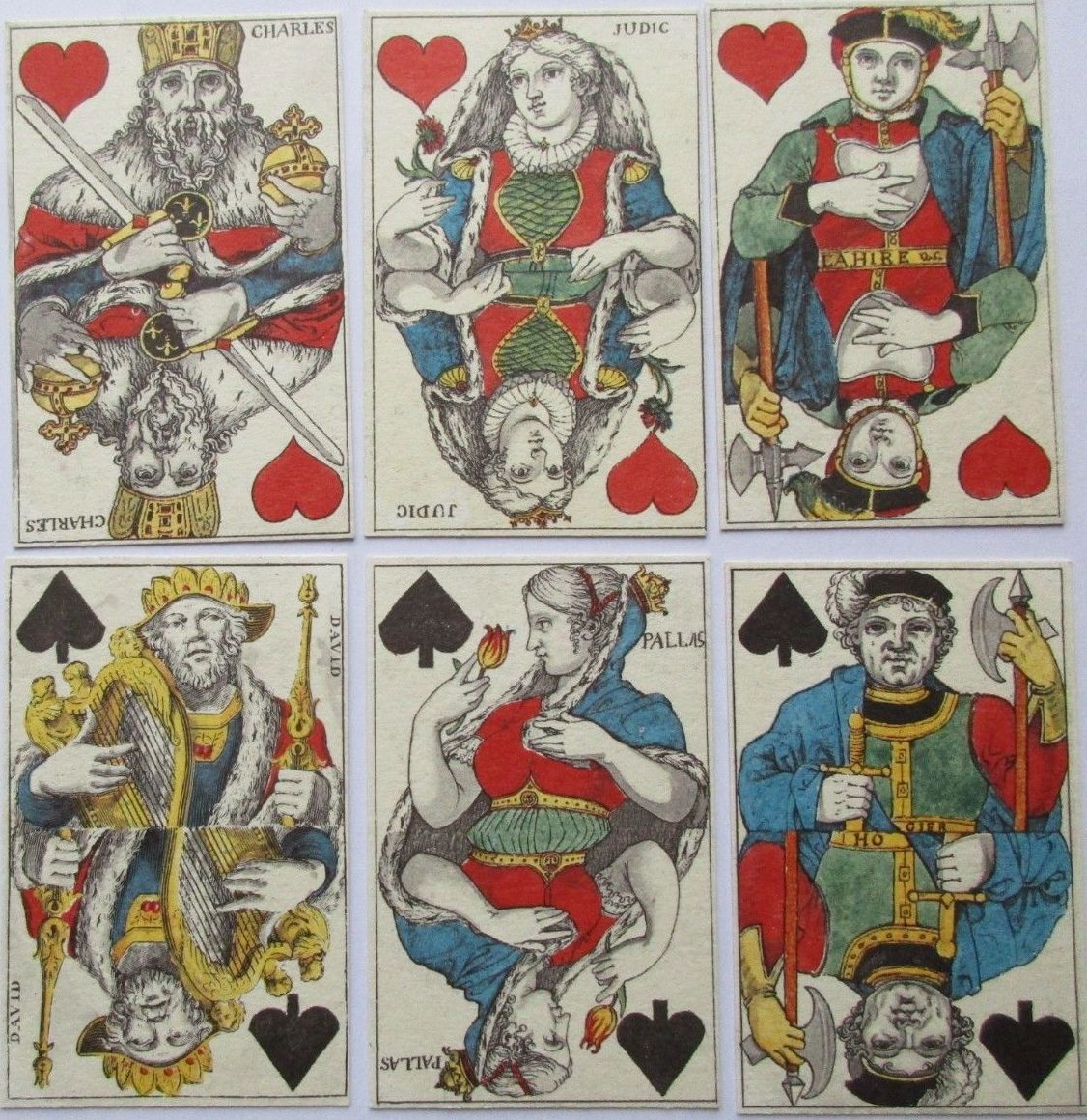
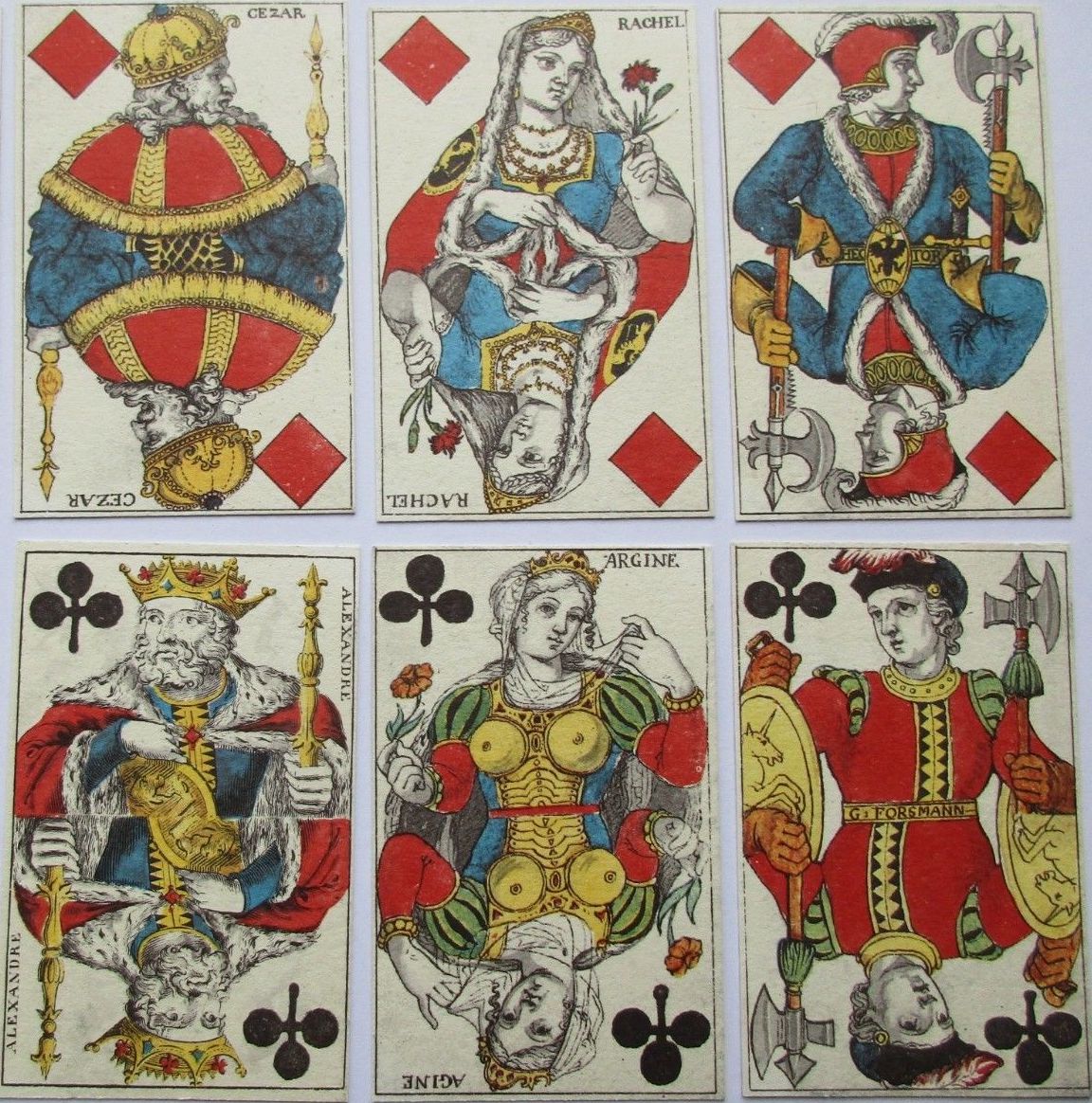 Above: Reproduction of Runge's 1810 designs. Notice in particular the front-facing JH and JS.
Above: Reproduction of Runge's 1810 designs. Notice in particular the front-facing JH and JS.
These designs were the basis of a version often referred to as the Hamburg pattern, as the makers were based in that city.
 Above: Anonymous, 1830s.
Above: Anonymous, 1830s.
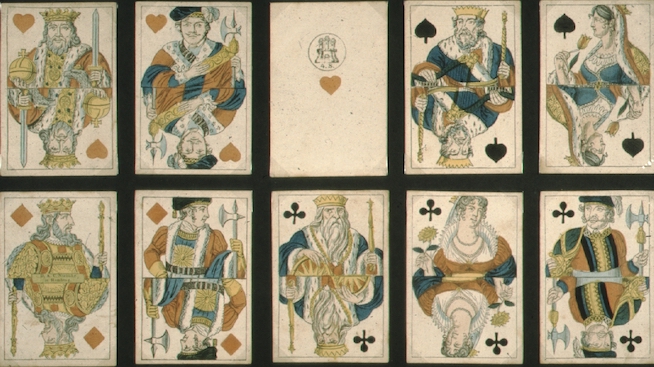 Above: Niebuhr, 1830s.
Above: Niebuhr, 1830s.
 Above: Gebrüder Suhr, 1830s.
Above: Gebrüder Suhr, 1830s.
The standard German "französisches Bild" took a somewhat different route, but retained some of the Runge features, e.g. the raised harp of the KS.
 Above: Stralsunder, c.1900.
Above: Stralsunder, c.1900.
 Above: Lattmann, c.1925.
Above: Lattmann, c.1925.
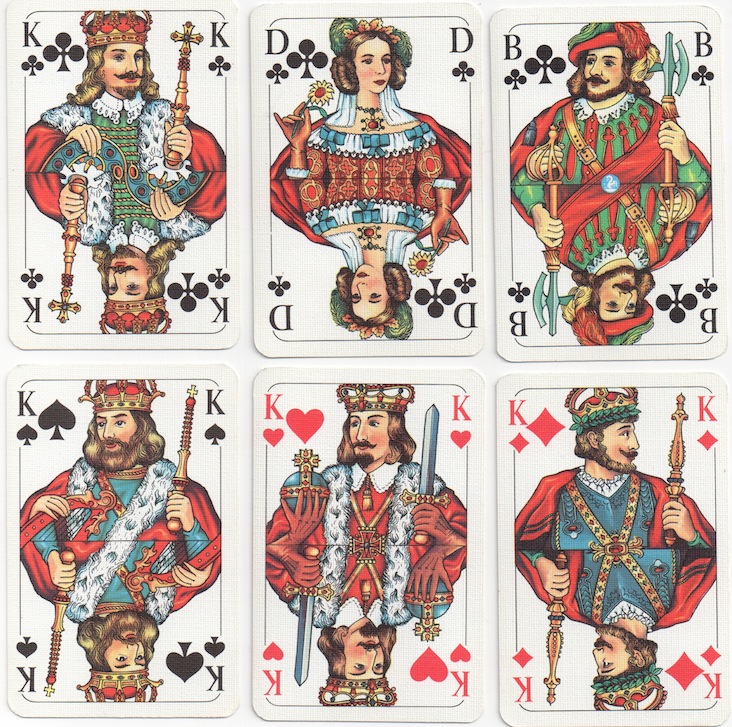 Above: Modern version by Pelikan.
Above: Modern version by Pelikan.
For some modern variants of the Berlin pattern, see page 28►
On the next page I'll look at some of the descendants of these regional patterns.
By Ken Lodge
United Kingdom • Member since May 14, 2012 • Contact
I'm Ken Lodge and have been collecting playing cards since I was about eighteen months old (1945). I am also a trained academic, so I can observe and analyze reasonably well. I've applied these analytical techniques over a long period of time to the study of playing cards and have managed to assemble a large amount of information about them, especially those of the standard English pattern. About Ken Lodge →

Leave a Reply
Your Name
Just nowRelated Articles

78: The Standard English pattern - Part 2, the tricky bits
There are many less straightforward aspects to the designs of the English pattern, which need carefu...
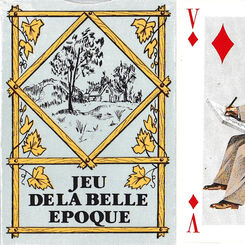
Jeu de la Belle Epoque
Jeu de la Belle Epoque, remembering a golden age of optimism, progress and elegance.
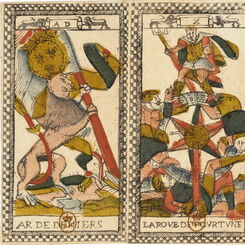
The Parisian Tarot
The “Parisian Tarot”, early 1600s, with imagery and design synthesizing several influences.

73: Fakes, forgeries and Tax Evasion
When there are oficial taxes to pay, people will find a way to avoid paying them - often illegally. ...
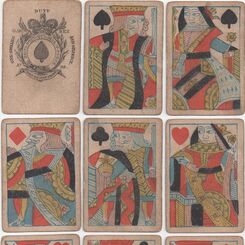
71: Woodblock and stencil: the hearts
A presentation of the main characteristics of the wood-block courts of the heart suit.
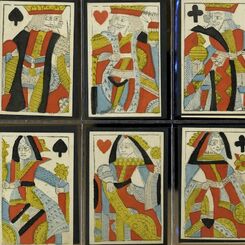
70: Woodblock and stencil : the spade courts
This is a presentation in a more straight forward fashion of the work done by Paul Bostock and me in...

64: The descendants of the French regional patterns: 2
A continuation oF the development of the off-spring of the Paris patterns and a few examples of how ...
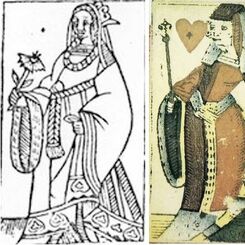
62: French regional patterns: the queens and jacks
Continuing our look at the figures from the regional patterns of France.
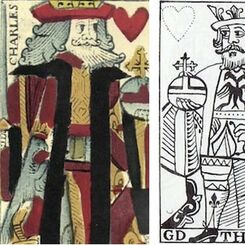
61: French regional patterns: the kings
On page 11 I illustrated several examples of the regional French patterns from Sylvia Mann's collect...

Trentine Pattern
Trentine Pattern

51: Some modern variations
A brief survey of some current variations in the standard English pattern.

25: More Standard European Cards
A further selection of European standard patterns including various redrawings.

19: 19th Century Breaks with Tradition - Unusual versions of the Standard English Pattern
The centuries-long tradition of English court cards was subject to misinterpretation and in some cas...
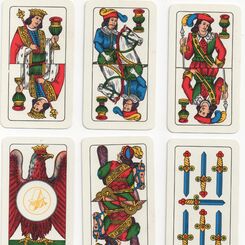
16: European Standard Playing Cards
A brief survey of the different types of standard cards to be found in Continental Europe.

Lyon Pattern type iii
This pattern was used in various parts of eastern France but was ultimately replaced by the official...
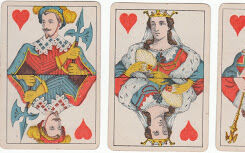
6: Some Non-Standard Cards
I only collect the English standard, but I thought it would be a good idea to add some different typ...
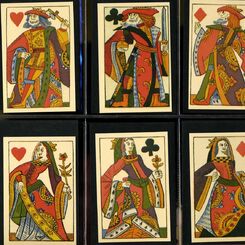
1: Playing Cards and their History: An Introduction and some links to other sites
What was considered the first mention of playing cards in England is in 1463 when Edward I banned th...

Paris Pattern
The Paris pattern was established as such around the middle of the seventeenth century (based, perha...

History of Court Cards
The court cards in English packs of playing cards derive from models produced by Pierre Marechal in ...
Most Popular
Our top articles from the past 60 days



 Your comment here. Your comment here. Your comment here. Your comment here. Your comment here. Your comment here. Your comment here. Your comment here. Your comment here. Your comment here. Your comment here. Your comment here. Your comment here. Your comment here. Your comment here. Your comment here. Your comment here. Your comment here. Your comment here. Your comment here. Your comment here. Your comment here. Your comment here. Your comment here. Your comment here. Your comment here. Your comment here. Your comment here. Your comment here. Your comment here. Your comment here. Your comment here.
Your comment here. Your comment here. Your comment here. Your comment here. Your comment here. Your comment here. Your comment here. Your comment here. Your comment here. Your comment here. Your comment here. Your comment here. Your comment here. Your comment here. Your comment here. Your comment here. Your comment here. Your comment here. Your comment here. Your comment here. Your comment here. Your comment here. Your comment here. Your comment here. Your comment here. Your comment here. Your comment here. Your comment here. Your comment here. Your comment here. Your comment here. Your comment here.





















